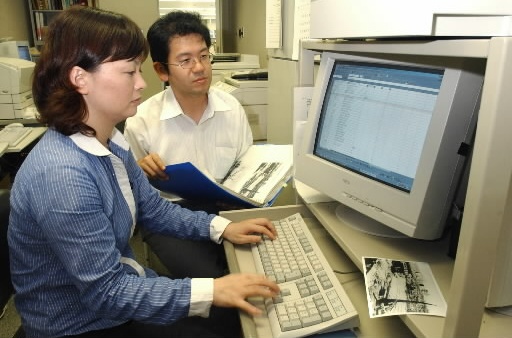Conveying the A-bomb Experience, Part 4
Jul. 5, 2010
Creating digital databases to hand down the bombing
by Kunihiko Sakurai, Masaki Kadowaki, and Takahiro Yamase, Staff Writers
The heat of the atomic fire, the agony of burned bodies, the grief wrought by families torn apart, the rage felt toward war… What should be done to etch the experiences borne of that day in our minds and in our memories, for generations to come, as the A-bomb survivors (hibakusha) and the family members of the A-bomb victims age? In this series (originally published in July and August 2004), the Chugoku Shimbun will consider the significance and challenges of conveying the A-bomb experience, with a focus on new efforts taking place in the A-bombed city of Hiroshima.
"In order to convey and disseminate the atomic bombing properly, it's vital to scrupulously preserve the testimonies of the A-bomb survivors and share these testimonies with everyone in the form of data." Katsuyuki Matsuki, 37, a city official who was transferred from the Hiroshima City Urban Development Bureau to the Outreach Division at Hiroshima Peace Memorial Museum, has come to strengthen his belief in such an effort this spring, marking his third year at the museum.
On August 1, the museum will update the "Peace Database," in which people, via the Internet, can search for nearly 70,000 articles preserved by the museum. The number of articles on display in the east and west wings of the museum is about 450, or less than one percent of the whole collection of the museum. The museum aims to promote people's interest in A-bomb artifacts by extending its exhibit space to the Internet.
The museum also intends to clearly record, in digital photos, deteriorating items that were once the belongings of A-bomb victims, such as clothes, letters, and the case for a train pass.
Mr. Matsuki is well-versed in computers and, on his own, has taken charge of processing a set of 90 videotapes which feature 270 people relating their accounts of the atomic bombing. In one account, a woman reveals how she had to cremate her own daughter's body. Her sad, hushed tone of her voice is touching to hear.
At the start of spring, before he began the process of editing the videotapes, Mr. Matsuki sent letters to each of the 270 people who provided their A-bomb account, asking if their testimonies can be added to the database. It turned out that the museum received replies from roughly 200 people who offered permission to show their testimonies to the public. However, the museum was unable to make contact with the others, and some letters were returned to the museum as undeliverable. The reality, 59 years after the atomic bombing, is that the number of hibakusha able to share their memories is declining. "I felt strongly that I must act fast," said Mr. Matsuki.
In updating the database, the museum will eliminate the prior procedures of confirming the identifications of visitors and requiring visitors to enter a password in order to access the database so that the site can be made readily available to peace education programs. The aim is for nearly all the materials held by the museum to be easily viewed from all over the world via computer.
Meanwhile, the number of visitors to the museum in fiscal 2003 decreased to 1,102,662, a decline of 3.3 percent from the previous fiscal year. Some people have voiced concern: "If the museum shows too many articles to the public via the Internet, it may keep people from visiting the museum."
Takafumi Sotowada, 51, deputy director of the museum, explained, "Sure, there is concern about this. But the materials cannot serve their roles only through their presence. We would like to put emphasis on how to pass them on to future generations."
At Hiroshima University's Research Institute for Radiation Biology and Medicine (RIRBM) in Minami Ward, Noriyuki Kawano, 38, a research assistant at the institute, shared his thoughts as he gazed hard at a computer screen: "Memories and feelings will fade away with time. But photos and documents can hand down the reality beyond time."
In June of this year, Hiroshima University opened its own database of materials related to the atomic bombings of Hiroshima and Nagasaki and other instances of exposure to radiation to researchers and A-bomb survivors. The database contains about 39,000 materials, including photos returned from the U.S. Armed Forces Institute of Pathology (AFIP) and newspaper articles on the themes of the atomic bombings and peace. By adding perspectives of the humanities and sociology, among other viewpoints, RIRBM aims to unravel the reality of the atomic bombings, which have often been described solely from medical and physical perspectives.
"Our society will lose the hibakusha before long. By then, we need to convey the atomic bombings, as facts, to the next generation," said Mr. Kawano. The creation of databases is an effort to resist the deterioration of materials and record the memories of the A-bombed cities.
(Originally published on July 25, 2004)








